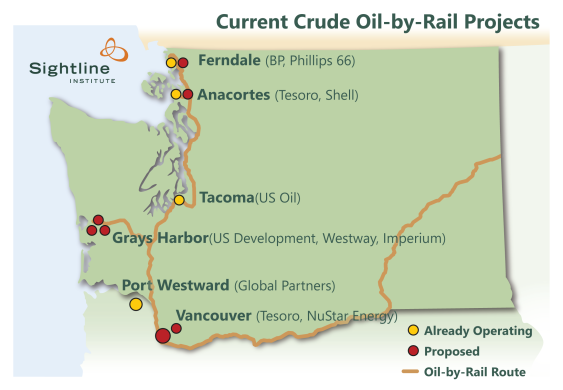Editor’s note: The report referenced below is a living document, and Sightline researchers update it regularly to reflect new developments. For the most recent facts and figures, please see the report, The Northwest’s Pipeline on Rails.
Sightline is re-releasing a popular report: The Northwest’s Pipeline on Rails. It’s the most comprehensive regional analysis of plans to ship crude oil by train. This update includes important new information showing far greater increases in oil train transport than previously thought. All told, the Northwest could soon be seeing 858,800 barrel of oil by rail per day—that more than the Keystone XL Pipeline would move.

Original Sightline Institute graphic, available under our Free Use Policy.
Moving large quantities of oil by rail would represent a major change for the Northwest’s energy economy, and the plans now in development puts the region’s communities at risk.
Why does it matter?
- In Oregon and Washington, 11 refineries and port terminals are planning, building, or already operating oil-by-rail shipments.
- If all of the projects were built and operated at full capacity, they would put more than 12 loaded mile-long trains per day on the Northwest’s railway system. Many worry about the risk of oil spills from thousands of loaded oil trains that may soon traverse the region each year.
- A string of high profile oil train explosions has raised widespread concern about the risks of

Original Sightline Institute graphic, available under our Free Use Policy.
moving crude oil by rail through populated areas. States and local governments across North America are beginning to seek more information about oil shipments and demand stricter tank car standards from federal regulators.
- Taken together, the oil-by-rail projects planned for the Northwest would be capable of delivering enough fuel to exceed the region’s oil refining capacity. Ironically, two of the facilities that would handle oil by rail were originally built to supply renewable fuels.
- The projects are designed to transport fuel from the Bakken oil formation in North Dakota, but the infrastructure could also be used to export Canadian tar sands oil. In fact, if all of the oil-by-rail projects were built, they would be capable of moving 858,800 barrels per day—that’s substantially more oil capacity than the planned Keystone XL pipeline.
- On Puget Sound, three of the region’s five refineries already receive oil-by-rail shipments, and the other two are planning new facilities. Three proposals for Grays Harbor would move oil along the Washington coast. And on the Columbia River, one port terminal is already receiving oil-by-rail shipments, while officials at Vancouver are planning by far the region’s largest facility and a nearby facility plans to transition to handling crude oil.

Original Sightline Institute graphic, available under our Free Use Policy.
Read the full report here: The Northwest’s Pipeline on Rails.










Davdi Moore
The Canada Transportation minister is requiring speed limits and updated tanker cars for oil trains. The US should at least meet this standard which could slow the process. The trains should also avoid or notify populated areas if possible when volatile fuels are traveling through.
Earl I. White
Eric,
Another excellent report that again shows that the cumulative impact of all fossil fuel transport proposals must the analyzed. There will be little benefit to Washingtonians from these terminals and they will suffer from the air pollution, congestion at railroad crossings, noise from the trains, water pollution, and the impacts on the Sound. A programmatic EIS must be done on all these proposals together.
Deb Rudnick
Eric, thank you for your continued ongoing excellent reporting and analyses. Can you speak at all as to why Governor Inslee appeared to be silent on the issue of oil and coal export through our state’s ports? Is it too much of a political hot potato?
Carie Saunders
Your map should indicate which rail lines run next to rivers. I am betting 90% do. These areas are extremely fragile and sensitive to oil spill damage. Why have we spent so many years and millions of dollars to study, regulate and mitigate wetland and riparian area development, only to see our gov’t allow these potentially catastrophic hazards running inches from our precious waterways? The value of our WA and ID Columbia or Snake River habitats is irreplaceable; we must not fail to imagine our own fisheries and riverbanks destroyed by burning oilslicks.
David Moore
The Bakken shale oil should be a resource for the future, not something to export as fast as possible. It contains lots of natural gas with the oil which is being flared thereby wasted. It also consumes huge amounts of water in the fracking process needed to grown food in that area. The oil will be needed to grow food and move it in the future as well.